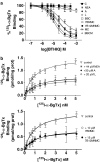Evaluation of benzyltetrahydroisoquinolines as ligands for neuronal nicotinic acetylcholine receptors
- PMID: 15980871
- PMCID: PMC1576253
- DOI: 10.1038/sj.bjp.0706307
Evaluation of benzyltetrahydroisoquinolines as ligands for neuronal nicotinic acetylcholine receptors
Abstract
Effects of derivatives of coclaurine (C), which mimic the 'eastern' or the nonquaternary halves of the alkaloids tetrandrine or d-tubocurarine, respectively, both of which are inhibitors of nicotinic acetylcholine receptors (nACh), were examined on recombinant, human alpha7, alpha4beta2 and alpha4beta4 nACh receptors expressed in Xenopus oocytes and clonal cell lines using two-electrode voltage clamping and radioligand binding techniques. In this limited series, Cs have higher affinity and are most potent at alpha4 subunit-containing-nACh receptors and least potent at homomeric alpha7 receptors, and this trend is very marked for the N-unsubstituted C and its O,O'-bisbenzyl derivative. 7-O-Benzyl-N-methylcoclaurine (BBCM) and its 12-O-methyl derivative showed the highest affinities and potencies at all three receptor subtypes, and this suggests that lipophilicity at C7 and/or C12 increases potency. Laudanosine and armepavine (A) were noncompetitive and voltage-dependent inhibitors of alpha7, alpha4beta2 or alpha4beta4 receptors, but the bulkier C7-benzylated 7BNMC (7-O-benzyl-N-methylcoclaurine) and 7B12MNMC (7-O-benzyl-N,12-O-dimethyl coclaurine) were voltage-independent, noncompetitive inhibitors of nACh receptors. Voltage-dependence was also lost on going from A to its N-ethyl analogue. These studies suggest that C derivatives may be useful tools for studies characterising the antagonist and ion channel sites on human alpha7, alpha4beta2 or alpha4beta4 nACh receptors and for revealing structure-function relationships for nACh receptor antagonists.
Figures






Similar articles
-
AE Succinimide, an Analogue of Methyllycaconitine, When Bound Generates a Nonconducting Conformation of the α4β2 Nicotinic Acetylcholine Receptor.ACS Chem Neurosci. 2020 Feb 5;11(3):344-355. doi: 10.1021/acschemneuro.9b00525. Epub 2020 Jan 14. ACS Chem Neurosci. 2020. PMID: 31898891
-
Effects of the plant alkaloid tetrandrine on human nicotinic acetylcholine receptors.Eur J Pharmacol. 2002 Aug 30;450(3):213-21. doi: 10.1016/s0014-2999(02)02155-6. Eur J Pharmacol. 2002. PMID: 12208312
-
Activity of cytisine and its brominated isosteres on recombinant human alpha7, alpha4beta2 and alpha4beta4 nicotinic acetylcholine receptors.J Neurochem. 2001 Sep;78(5):1029-43. doi: 10.1046/j.1471-4159.2001.00481.x. J Neurochem. 2001. PMID: 11553677
-
Halogenated cytisine derivatives as agonists at human neuronal nicotinic acetylcholine receptor subtypes.Neuropharmacology. 2003 Mar;44(4):503-15. doi: 10.1016/s0028-3908(03)00025-x. Neuropharmacology. 2003. PMID: 12646287
-
Nicotinic acetylcholine receptors at the single-channel level.Br J Pharmacol. 2018 Jun;175(11):1789-1804. doi: 10.1111/bph.13770. Epub 2017 Apr 8. Br J Pharmacol. 2018. PMID: 28261794 Free PMC article. Review.
Cited by
-
Effects of Natural Monoamine Oxidase Inhibitors on Anxiety-Like Behavior in Zebrafish.Front Pharmacol. 2021 May 13;12:669370. doi: 10.3389/fphar.2021.669370. eCollection 2021. Front Pharmacol. 2021. PMID: 34079463 Free PMC article.
-
Production of benzylisoquinoline alkaloids in Saccharomyces cerevisiae.Nat Chem Biol. 2008 Sep;4(9):564-73. doi: 10.1038/nchembio.105. Nat Chem Biol. 2008. PMID: 18690217 Free PMC article.
-
Synthesis of a unique isoindoline/tetrahydroisoquinoline-based tricyclic sultam library utilizing a Heck-aza-Michael strategy.ACS Comb Sci. 2012 Mar 12;14(3):211-7. doi: 10.1021/co200181x. Epub 2012 Feb 6. ACS Comb Sci. 2012. PMID: 22311745 Free PMC article.
-
Assessment of Insecticidal Activity of Benzylisoquinoline Alkaloids from Chilean Rhamnaceae Plants against Fruit-Fly Drosophila melanogaster and the Lepidopteran Crop Pest Cydia pomonella.Molecules. 2020 Nov 3;25(21):5094. doi: 10.3390/molecules25215094. Molecules. 2020. PMID: 33153001 Free PMC article.
References
-
- ASTLES P.C., BAKER R.S., BOOT J.R., BROAD L.M., DELL C.P., KEENAN M. Recent progress in the development of subtype selective nicotinic acetylcholine receptor ligands. Curr. Drug Targets – CNS Neurol. Disord. 2002;1:337–348. - PubMed
-
- BUCK K.T.Bisbenzylisoquinolines The Alkaloids 1987New York: Academic Press; 1–222.ed. Brossi, A. pp
-
- CACHELIN A.B., RUST G. Unusual pharmacology of (+)-tubocurarine with rat neuronal nicotinic acetylcholine receptors containing β4 subunits. Mol. Pharmacol. 1994;46:1168–1174. - PubMed
Publication types
MeSH terms
Substances
Grants and funding
LinkOut - more resources
Full Text Sources
Other Literature Sources
Miscellaneous

